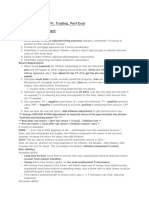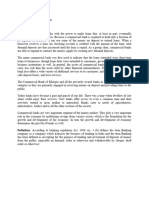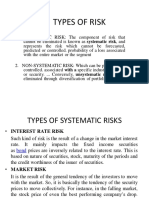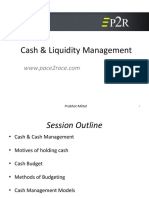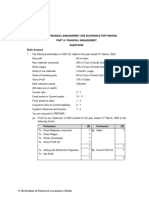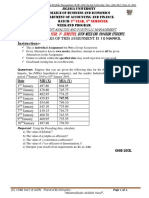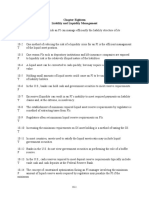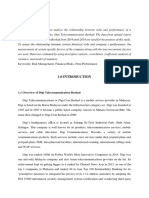Credit Management Overview and Principles of Lending
Credit Management Overview and Principles of Lending
Uploaded by
Tavneet SinghCopyright:
Available Formats
Credit Management Overview and Principles of Lending
Credit Management Overview and Principles of Lending
Uploaded by
Tavneet SinghCopyright
Available Formats
Share this document
Did you find this document useful?
Is this content inappropriate?
Copyright:
Available Formats
Credit Management Overview and Principles of Lending
Credit Management Overview and Principles of Lending
Uploaded by
Tavneet SinghCopyright:
Available Formats
CREDIT MANAGEMENTOVERVIEW AND PRINCIPLES OF LENDING
What is Credit Credit is defined as confidence in borrowers ability & intentions to repay the loan extended to him by the creditor. Credit has become an integral part of modern industrialization economies. It has been considered as oil of the commerce. It contributes to the industrial growth and economic development. What is Credit Management Credit Management usually deals with the credit vetting of the customers, allocation of available funds to different sectors/segments of the economy, diversifying the applicable risk in extending credit, internal funds movements & reconciliation, as also maintaining relations with the customers
What are goals of Credit Management in Banks - Optimize the mix of Banks assets - Minimize bad debt loss - Analyze customer credit risk - Maintain financial flexibility - Be responsive to individual customer - Respect overall corporate financial constraints - Credit Managers must become strategic partners in business operations - Credit Managers should learn how to manage people of different culture - A Credit system is a foundation stone of modern economy
Credit Management has two facets : -Credit Appraisal & Credit Monitoring. Credit Appraisal deals with the evaluation of credit needs of the borrower, his worthiness, his ability, his risk, policy regarding extension of credit to the borrowers, terms and conditions of the credit, sanctioning process of the Bank and involves a decision whether to extend the credit or not to the customer- pre sanction stage. Once a decision to extend the credit is taken, the borrower is asked to complete all the formalities of the terms and conditions, signing of the documents etc.(Pre disbursal stage). After which the credit is disbursed to the borrower.
Credit Monitoring This is a post disbursal period and is very important for the banker since the health of the unit is determined during this phase. Banks are required to keep constant watch on the unit vis--vis the loan account after disbursal of the loan, to ensure that the amount disbursed to the unit is safe, is being utilised for the purpose extended (ensuring end use of funds), generates income and does not turn out to be sick. There are three types of follow up that constitutes credit monitoring (a) Financial follow up (b) Physical follow up (c) Legal follow up
Warning Signals The loan account by itself would indicate explicitly the quality of the loan. There are bound to be warning signals before an account goes bad viz., (i) Reductions in credits (deposit entries) in the loan account if it is a working capital account (ii) issuing cheques to the creditors by the borrower in excess of the limit/Drawing Power (DP) available in the account, thereby frequent returning of these cheques (iii) Delays and defaults in repaying the interest/ instalments (iv) Non-submission/Delay in submission of the stock statements and/or financial data to the Bank. There is a need to identify these signals emanating from a loan
account. If the Bank does not take prompt follow up action, it could result in further defaults, thereby leading to a further degeneration in the quality of the loan and create problem loans. -Documentation The Banker grants financial facility to its customer under a valid contract, the terms and conditions of the financial assistance are enumerated. Further, the terms of repayment as well as the consequences in the event of breach of conditions are enumerated. As a part of initial exercise, during the post sanction phase, the bank obtains certain documents from the borrower/competent authority of the borrowing Company duly signed so as to bind the borrower legally and enforce
charge. The importance of the documents lies in the fact that with proper documentation in force, there will not be any problem in enforcing a claim by the bank in case of a default by the borrower. LEGAL REMEDY In case of persistent default by the customer, where all other measures taken by the banker including reviving of the unit are not successful, the recourse open to the bank is (i) Enforce the repayment or enforce the security available through the Court of Law. A common complaint of the banks and financial institutions had been that they were facing enormous bottlenecks in the recovery of loans through the Civil Courts. In view of this the Government took initiative and established Debt Recovery Tribunals (DRTs). However, even after establishment of DRTs, enforcing security is still a time consuming process.
In this connection on recommendations of Narsimahan Committee for the purpose of examining Banking Sector reforms, the GOI promulgated Securitization and Reconstruction of Financial Assets and Enforcement of Security Interest Ordinance 2002 (SARFAESI) which was later on replaced by an Act . The provisions of this act will enable Banks and Financial Institutions to exercise power in taking over the possession of the securities, sell them and reduce their non-performing assets. (ii) To enter into a compromise proposal with the defaulting borrower.
Excel Bank Ltd. has sanctioned following credit limits to Andheri Enterprises Ltd.: Cash- Credit Rs. 20 cr Bills Discounting Rs.5 cr Term Loan Rs. 10 cr L/C Rs. 5 cr The stock statement submitted by M/s.Andheri Enterprises as on 30/06/2010 is as follows : Raw Material : 8 cr WIP Rs.3 cr FG: Rs. 8 cr Receivables: Rs.8 cr (including receivables of Rs. 2 cr which are more than 6 months & excluding those included under Bills Discounting Limit). The present outstanding as on 15/10/2010 in CashCredit account are Rs.22 cr (including overdrawing) and the account has remained continuously irregular since 14/09/2010
. First Term Loan installment of Rs. 2cr and quarterly interest amounting to Rs.0.60 cr has also remained unpaid till date. Further, Bills discounted limit is fully utilised, however, bills amounting to Rs.1.60 cr due for retirement till date also remained unpaid. The margins applicable to RM, WIP, FG, Receivables are 30%, 40%, 30%& 40%. 8 Cheques amounting to Rs.3.40 crs have been recently returned for want of required DP in the account.
Question:
Calculate the amount of irregularity in the account as on date. What action should the bank take under the circumstances.
Risk Management : Banks Traditional role is to mobilize the funds from the household sector/surplus from the Corporates and deploy it with the household and Corporate Sector for consumption/productive purpose. Its role is that of intermidiary. As such Banks are exposed to various risks. The price at which the Banks mobilize and transfer funds depend on two parameters the time for which the funds are made available and credit worthiness of the person to whom the funds are made available. Considering long term loans are priced higher than short term loans and a high risk borrower pays a higher price (interest), banks will have to factor liquidity risk and/or
credit risk to earn spreads. There is also a definite linkage between the various risks faced by the banks. For example, if the bank charges a client floating rate of interest, in case of increasing rate scenario, the banks interest rate risk will be lower. Consequently, the payment obligations of the borrower increases. Other things remaining constant, the default risk increases if the client is not able to bear the burden of the rising rates. There are many instances where the interest rate eventually leads to credit risk. A top priority of the banks is to improve their asset quality by minimizing and managing their credit risk. A robust credit risk management framework with a proper risk management model coupled with the sound/speedy legal framework improves the quality of the assets.
Another technique being employed by the Banks to reduce interest and liquidity risk is AssetLiability Management (ALM). ALM has both macro and micro level implications. At macro level it leads to the formulation of critical business policies, efficient allocation of capital and designing of products with appropriate pricing strategies. At micro level, the objective is two fold it aims profitability through price-matching and ensuring liquidity by maturity matching. Price matching maintains spreads by ensuring deployments of liabilities is at a rate higher than the cost. Similarly, grouping the assets/liabilities based on their maturity profile ensures liquidity. The gap is
then assessed to identify the future financing requirements. Credit Information: Banks and lending institutions have a traditional resistance, to share credit information because of confidential nature of banker-customer relationship. To serve this purpose and to make credit and other data available specialised institutions known as Credit information bureaus have been set up. They serve as repository of current & historical data of the existing and potential customers.
CREDIT INFORMATION BUREAU OF INDIA LTD.(CIBIL) CIBIL was promoted by SBI, HDFC, Dun & Bradstreet Information services (P) Ltd. to provide credit information of clients to its members. Presently, its shareholding pattern has been diversified to include number of banks and finance companies. CIBIL collects commercial and consumer creditdata and collates such data to create and distributes credit reports to its members. CIBIL primarily gets information from its members and at subsequent stage will supplement it with public domain information in order to create a
truly comprehensive snapshot of an entitys financial track record. A Credit information report is a factual record of borrowers credit payment history. Its purpose is to help credit grantors make informed lending decisions-quickly and objectively. CIBIL caters to both consumer and commercial sectors. Consumer Credit Bureau covers credit availed by individuals while the Commercial Credit Bureau covers credit availed by non-individuals e.g. partnership firms, proprietary concerns, Private and Public Ltd. companies etc.
TYPE OF INFORMATION AVAILABLE ON BORROWER: - Basic information like Name, Address, ID No., Passport ID, Voters ID, Date of birth, Registration No., Date of incorporation, Legal Constitutions, Board of Directors etc. - Record of all the credit facilities availed by the borrower - Past Payment history - Amount overdue (if any) - Suit filed status - No. of enquiries made on that borrower by member
INFORMATION NOT INCLUDED IN CIR - Income/Revenue details - Details of deposits with the banks - Details of the borrowers assets - Value of assets mortgaged - Details of investments CIBIL itself does not classify any accounts as defaults account. It merely reflects the information of Asset Classification as per members record. LENDING DECISION: CIBIL CIR only provides available credit information and does not provide any opinion, indication or comment pertaining whether credit should or should not be granted.
The Credit grantors who have received an application for credit will make the credit decision. CIBIL does not own any responsibility merely on the basis of Credit information provided to the creditor. RIGHT TO INFORMATION ACT 2005 IS NOT APPLICABLE TO CIBIL CIBIL is not a public authority. CREDIT FACILITIES EXTENDED BY THE BANKS: RETAIL : Risk Assessment on Scoring Model Personal Loans: Amount sanctioned: Multiple of Monthly Income/Annual Income, Repayment 3-7 years, Documentation- Loan Application, Loan Agreement, Demand Promissory Note (DP Note) Check-off facility (if available), PDCs for EMIs or
mandate to debit the account through ECS for monthly repayments. Consumer loans: To buy consumer goods, Margin Nil to 25%, Repayment 3-7 years, documents as in personal loan additionaly Hypothecation agreement Vehicle Loans: Cars/Scooters Margin 5% to 25%, Period 5-7 years, Documents as above, Charge to be registered with RTO, Comprehensive Insurance to include Bank clause Home Loans: Home Loans against mortgage of property, Equitable Mortgage is preferred, Credit extended may be 60% to 85% of the cost of house/cost of construction, Period may range
from 10 to 30 years depending upon income and age of the borrower. Title Documents relating to property are called for verification of ownership. Photocopies of these documents are sent to Banks Legal Advisor to seek his opinion regarding ownership of the customer and also to know if the valid equitable mortgage can be created against the property. Sometimes, if necessary technical report from approved valuer to know the market value of the property is also called for. Documentation: Home Loan application, Loan agreement, personal guarantee agreements from the acceptable guarantors, Personal guarantee of the spouse/
legal heir, Deposit of titles of the property for equitable mortgage, independent letter to be sent by the customer to the bank detailing the details of the property and his independent acceptability to equitable mortgage the property, Recital to be prepared by the Banker, PDCs or ECS mandate for EMIs. Construction of house : Inspection, progressive payments on the basis of architects certificate, if title deed is not available, obtain any other acceptable security for the intervening period. Education Loan: Admission must be granted by a Recognised Institution, good academic track record of the student, Family financial position, scoring model
MARGIN : Upto Rs 4 lacsNilAbove Rs. 4 lacs : Studies in India5%Studies Abroad15%- Scholarship/ assistantship to be included in margin. - Margin may be brought-in on year-to-year basis as and when disbursements are made on a pro-rata basis. SECURITY : Upto Rs 4 lacsCo-obligation of parents. No securityAbove Rs.4 lacs and upto Rs7.5 lakhsCoobligation of parents together with collateral security in the form of suitable third party guarantee. The bank may, at its discretion, in exceptional cases, waive third party guarantee if satisfied with the net-worth / means of parent/s who would be executing the document as joint borrower.Above Rs.7.5 lakhsCo-obligation of parents together with tangible collateral security of suitable value, along with the assignment of future income of the student for payment of instalments Loan application, Loan agreement to be signed by the student and parents, personal guarantee agreements (if applicable)
Loan repayment to start as soon as the student gets employment or within 6 months of the completition of the course. LOAN AGAINST SHARES OF THE LISTED COMPANIES: Sanctioned both as demand loan or Limit/DP in Current Account. Facility should be extended only in case of listed companies. Amount sanctioned should not be more than 50% of the average market price of the share. Documents: Application form, DP Note, Transfer deed duly signed by the shareholder. If EMIPDCS/ECS, Bullet Payment. LOAN AGAINST BANKS OWN FDRS/NSCs etc. Sanctioned both as demand loan or Limit/DP in Current Account. Margin 25% Lien of Bank is
noted (in case of NSCs/ KVPs with the issuing Post Office) Documents: FDR/NSCS/KVPs duly discharged by the customer, Application for loan, DP Note. COMMERCIAL CREDIT FACILITIES: Credit Facilities are extended to proprietary firms, partnership firms, SMES/SSIs, Private Ltd. and Public Limited Companies based on their CRA. The credit facility extended may be either Funded Facility or Non Funded Facility. FUNDED FACILITIES: (a) Working Capital: Cash-Credit Limit (CC Limit)
Temporary Overdraft Limit, Bill Discounting, CP Linked Working Capial loan Loan for Purchase of Fixed Assets: Term Loan, Corporate Loan NON FUNDED FACILITIES: Letter of Credits (L/Cs) and Bank Guarantees EXPORT FINANCE: PRESHIPMENT FINANCE: EXPORT Packing Credit (EPC) denominated in Rupees, Packing Credit in Foreign Currency (PCFC) denominated in Euro, Dollar, Pound, Yen Post Shipment Finance: Foreign Bill discounting Limit with or without L/C
IMPORT CREDIT: Letter of Credit (L/c) for import of machinery/material etc. PRINCIPLES OF LENDING: Credit Management is concerned with the sound principles of lending which are mainly concerned with the activity of the borrower and the profile of the borrower as individual. ACTIVITY: (a) Ensuring safety: Bank being a custodian of funds of the depositors must ensure safety of the funds deployed and lend the funds only to reliable borrowers, who after generating surplus
from their business can repay back the loan amount along with the interest. Banks traditionally create charge on collateral marketable securities of the borrower, in addition to the primary security. This enables them to dispose off the marketable securities in case of default by the borrower and recover the amount of defaulted loan. But with changing time and the banks having assumed the role of fore-runners in the socio-economic development with the extension of credit to the non-traditional and neglected sector, sufficient collaterals may not be available to the banks. Thus the viability of the business and its capacity to generate surplus
becomes best security for the Banks. To ensure safety of the funds this aspect has assumed more importance than the collaterals. (b) Ensuring Liquidity: The Banker mobilises funds from the depositors and lends the same to the borrowers on specified repayment terms. The borrower should be able to generate surplus funds to repay back to the banker, otherwise liquidity of the banker gets affected and in turn he may not be able to repay back the depositors funds on terms and conditions deposit is mobilised. A banks inability to meet the demand for withdrawals of the depositors can lead to a run on the bank, which can pose a
threat to its basic survival. Thus the exercise of ensuring liquidity with the borrower also amounts to ensuing liquidity with the bank. Liquidity would also refer to the quality of assets which should be easily convertible into cash without any loss of value. Thus the concept of liquidity entails the banker to look for easy saleability and absence of risk of loss on sale of assets, which has been taken on collateral. (c) Generate Profits: Banks provide various credit facilities & other services to the customers and it is also prudent on the part of the banker to extend certain concessions to the customer on some of the services, in view of competition
amongst the banks. Thus the banks consider overall profitability of the business extended to the bank by the customer rather than profitability against each component of the business or service offered. Such an analysis of the business from the customer is known as customer profitability analysis or more often in the language of the bankers Value of the account. Thus there is a direct relationship between profit and pricing of services offered by the banker. Example: In case if a customer is availing of substantial credit limits in working capital/Term Loan and the amount of interest earned in the previous years is substantial,
concession may be given to the customer in rate of remittances / non-funded business or viceversa. (d) Purpose: Banks should lend the funds only for productive purposes and should also ensure End use of funds. Banks should not lend funds for unproductive purposes, speculative purposes, hoarding stocks or for anti-social activities, since apart from morality such activities have inherent risks involved with regard to repayment of loan. (e) Adequate security: Banks traditionally extend credit facility against collateral security.However,
bank before extending credit facility must ensure that collateral is sufficient to cover the loan amount, is easily marketable and is free of charges. (f) Risk Management through diversification: The principle of never keep all the eggs in the same basket applies to lending also. Banks should lend to a large number of industries and borrowers, so that risk gets diversified. EVALUATION OF THE BORROWER-THE 6Cs INDIVIDUAL PROFILE ASSESSMENT (A) CHARACTER: Appraise personal characteristic of the borrower honesty, attitude,
willingness and commitment to repay debts. Banker needs to be careful and will have to use all his diligence and resources to find out the true character of the borrower. Banker should be familiar with the reputation of the borrower. Character also includes responsibility, integrity and consistency, which shall form the basis, on which borrowers willingness to repay loans can be determined. (B) Capacity: An assessment of whether the borrower has the potential to repay the loan from his resources. Worth of the borrower and his competence-running business, managing cash flows, physical assets, plants, equipments, labor
and management skills. Banks generally insist upon their prospective borrowers to submit their financial statements in order to determine their credit worthiness. (C) Collateral: The prime principle of the banker in credit management is safety of funds. This can be achieved by obtaining proper security i.e., collateral should have adequate value, marketability so that in case it is required to be enforced the same can be sold with least effort, cost & sufficient to cover the defaulted amount. The bankers at the time of appraisal may require the valuation of collateral offered be valued by
an approved valuer. (D) Capital: The banker has to assess the financial strength of the borrower or his Tangible Net Worth (TNW). It represents the amount of equity capital that a firm can liquidate for payment of debt in the eventuality of all other means failing. The amount of borrowers capital in relation to debt is relatively easy to compute. However, the valuation of underlying assets in which capital is invested is a complex and vital exercise. There could be substantial difference between the book value and the market value of the capital. (Monthly Stock verification, Stock Audits)
(E) Conditions: Banker needs to evaluate conditions in which the borrower is operating his business. STEP Analysis-Social, Technological, economic & Political conditions. These conditions affect the growth prospects of the firm and in eventuality affect the repaying capacity of the borrower. Incidentally, external conditions such as recession, interest rate shocks and asset price deflation can adversely affect the borrowers and contribute to their defaulting the loan. (F) Compliance: The banker needs to assess that loans granted are in conformity with the guidelines as specified from time to time by the
Government, other regulatory authorities and as per the Loan Policy of the Bank. In the absence of compliance , it will be difficult for the Banker to recover the loan in case of default.
LETTER OF CREDIT: It is a financial instrument issued by the bank on application of its customer (importer/purchaser) in favour of exporter/seller, guaranteeing reimbursement of drafts (Bills of exchange) drawn by the exporter/seller for the supplies upto certain amount and within a specified period as per terms enumerated in the L/c. Parties involved: Applicant-Importer/Purchaser Opening Bank/Issuing Bank Advising Bank Beneficiary
Types of L/cs: Revocable L/c, Irrevocable L/c, Deferred Payment L/c: Allows Bank to make payment in predetermined instalments Confirmed L/c ; Unconfirmed L/c Revolving L/c Transferable L/c Back to back L/c Anticipatory L/c Red clause letter L/c, Green Letter clause L/c
Guarantees: Sec.126 of the Contract Act. A contract of guarantee is a contract to perform the promise or discharge the liability of the third person in case of his default. The person who gives the guarantee is called surety; the person on whose behalf /default the guarantee is given is called principal debtor and the person to whom the guarantee is given is called creditor/beneficiary. The liability of a guarantor/ surety comes into existence upon the failure of a debtor. If the surety extinguishes the liability of a debtor, then the surety will acquire all the rights of the creditor, known as right of subrogation.
Types of Guarantees: Financial Guarantees: Bid/Tender Guarantee, Deferred Payment Guarantee Performance Guarantees: APG, PG,RMG A DPG is a Financial Guarantee and can be said to be a substitute of Term Loan. Difference between the two is that in case of Term Loan, the lender bank lays down funds to the extent loan extended for the purchase of FA. In case of DPG the bank does not lays down the funds for acquiring FA by the borrower but has to make sure that the borrower has sufficient cash flows at the time of retirement of bills drawn by the
Seller and got discounted by his bank on the strength of the purchaser/importers bank. It is therefore necessary that the various aspects of appraisal of the project viz. economics of the project, its technical feasibility and economic viability etc. are assessed in detail, as done in case of Term Loan.
You might also like
- The Role of Artificial Intelligence in Risk ManagementNo ratings yetThe Role of Artificial Intelligence in Risk Management12 pages
- CFA PM, AA, Econ, FI, Trading, Perf EvalNo ratings yetCFA PM, AA, Econ, FI, Trading, Perf Eval42 pages
- CASE STUDY Trends in International BankingNo ratings yetCASE STUDY Trends in International Banking9 pages
- LVA, FVA, CVA, DVA Impacts On Derivatives ManagementNo ratings yetLVA, FVA, CVA, DVA Impacts On Derivatives Management39 pages
- Derivatives and Risk Management JP Morgan ReportNo ratings yetDerivatives and Risk Management JP Morgan Report24 pages
- I. Multiple Choice. Read and Select The Best Answer in Each QuestionNo ratings yetI. Multiple Choice. Read and Select The Best Answer in Each Question1 page
- R48 Derivative Markets and Instruments IFT NotesNo ratings yetR48 Derivative Markets and Instruments IFT Notes22 pages
- Bangladesh Cost Accounting Standards (BCAS)No ratings yetBangladesh Cost Accounting Standards (BCAS)5 pages
- Risk and Rate of Returns in Financial ManagementNo ratings yetRisk and Rate of Returns in Financial Management50 pages
- Difference Between Profit Maximization and Wealth Maximization Financial ManagementNo ratings yetDifference Between Profit Maximization and Wealth Maximization Financial Management6 pages
- Banking and Financial Institution MOST IMPORTANT MCQ by AKASHNo ratings yetBanking and Financial Institution MOST IMPORTANT MCQ by AKASH100 pages
- International Financial Management Chapter 5 by PG Apte100% (1)International Financial Management Chapter 5 by PG Apte22 pages
- The Factors Affecting The Adoption of Online Banking Services by Civil Servants in Cameroon100% (1)The Factors Affecting The Adoption of Online Banking Services by Civil Servants in Cameroon8 pages
- Impact of Inflation On The Financial StatementsNo ratings yetImpact of Inflation On The Financial Statements22 pages
- Factoring and Forfaiting Notes M.Com Sem-IV - Sukumar PalNo ratings yetFactoring and Forfaiting Notes M.Com Sem-IV - Sukumar Pal20 pages
- Frequently Asked Questions: Credit Guarantee Fund For Micro Units (CGFMU)No ratings yetFrequently Asked Questions: Credit Guarantee Fund For Micro Units (CGFMU)4 pages
- COURSE OUTLINE - Project and Infrastructure FinanceNo ratings yetCOURSE OUTLINE - Project and Infrastructure Finance6 pages
- Questions Financial Statements Financial AnalysisNo ratings yetQuestions Financial Statements Financial Analysis3 pages
- RSKMGT Module II Credit Risk CH 4 - Prediction of Exposure at DefaultNo ratings yetRSKMGT Module II Credit Risk CH 4 - Prediction of Exposure at Default8 pages
- Banking and Financial Services - Vi Sem - BbaNo ratings yetBanking and Financial Services - Vi Sem - Bba24 pages
- Tandon Committe & Tarapore Committee SuggestionNo ratings yetTandon Committe & Tarapore Committee Suggestion6 pages
- Credit Management Overview and Principles of Lending100% (4)Credit Management Overview and Principles of Lending55 pages
- Credit Appraisal Process & Financial Parameters100% (1)Credit Appraisal Process & Financial Parameters35 pages
- Financial Statement Analysis and Performance Evaluation of Banks A Comparative Study Between Conventional Banks and Islamic Banks in Bangladesh100% (1)Financial Statement Analysis and Performance Evaluation of Banks A Comparative Study Between Conventional Banks and Islamic Banks in Bangladesh50 pages
- Spotle - Ai Data Science Final Capstone Project Building An Credit Card Analyser Using Decision Tree ClassifierNo ratings yetSpotle - Ai Data Science Final Capstone Project Building An Credit Card Analyser Using Decision Tree Classifier4 pages
- The Relationship Between Risks and Company Performance Digi BerhadNo ratings yetThe Relationship Between Risks and Company Performance Digi Berhad24 pages
- Disclosure Report On BAHTNET Self-Assessment Against The Principles For Financial Market InfrastructuresNo ratings yetDisclosure Report On BAHTNET Self-Assessment Against The Principles For Financial Market Infrastructures31 pages
- Chapter 8 An Economic Analysis of Financial Structure100% (2)Chapter 8 An Economic Analysis of Financial Structure14 pages
- Michael Stegman MBA Remarks On Future of GSEsNo ratings yetMichael Stegman MBA Remarks On Future of GSEs4 pages
- Credit Management Policy and Financial Performance in Financial Institutions in Uganda A Case of Selected Centenary Bank Branches in Rwenzori RegionNo ratings yetCredit Management Policy and Financial Performance in Financial Institutions in Uganda A Case of Selected Centenary Bank Branches in Rwenzori Region16 pages
- The Role of Artificial Intelligence in Risk ManagementThe Role of Artificial Intelligence in Risk Management
- LVA, FVA, CVA, DVA Impacts On Derivatives ManagementLVA, FVA, CVA, DVA Impacts On Derivatives Management
- I. Multiple Choice. Read and Select The Best Answer in Each QuestionI. Multiple Choice. Read and Select The Best Answer in Each Question
- Difference Between Profit Maximization and Wealth Maximization Financial ManagementDifference Between Profit Maximization and Wealth Maximization Financial Management
- Banking and Financial Institution MOST IMPORTANT MCQ by AKASHBanking and Financial Institution MOST IMPORTANT MCQ by AKASH
- International Financial Management Chapter 5 by PG ApteInternational Financial Management Chapter 5 by PG Apte
- The Factors Affecting The Adoption of Online Banking Services by Civil Servants in CameroonThe Factors Affecting The Adoption of Online Banking Services by Civil Servants in Cameroon
- Factoring and Forfaiting Notes M.Com Sem-IV - Sukumar PalFactoring and Forfaiting Notes M.Com Sem-IV - Sukumar Pal
- Frequently Asked Questions: Credit Guarantee Fund For Micro Units (CGFMU)Frequently Asked Questions: Credit Guarantee Fund For Micro Units (CGFMU)
- COURSE OUTLINE - Project and Infrastructure FinanceCOURSE OUTLINE - Project and Infrastructure Finance
- RSKMGT Module II Credit Risk CH 4 - Prediction of Exposure at DefaultRSKMGT Module II Credit Risk CH 4 - Prediction of Exposure at Default
- Credit Management Overview and Principles of LendingCredit Management Overview and Principles of Lending
- Financial Statement Analysis and Performance Evaluation of Banks A Comparative Study Between Conventional Banks and Islamic Banks in BangladeshFinancial Statement Analysis and Performance Evaluation of Banks A Comparative Study Between Conventional Banks and Islamic Banks in Bangladesh
- Spotle - Ai Data Science Final Capstone Project Building An Credit Card Analyser Using Decision Tree ClassifierSpotle - Ai Data Science Final Capstone Project Building An Credit Card Analyser Using Decision Tree Classifier
- The Relationship Between Risks and Company Performance Digi BerhadThe Relationship Between Risks and Company Performance Digi Berhad
- Disclosure Report On BAHTNET Self-Assessment Against The Principles For Financial Market InfrastructuresDisclosure Report On BAHTNET Self-Assessment Against The Principles For Financial Market Infrastructures
- Chapter 8 An Economic Analysis of Financial StructureChapter 8 An Economic Analysis of Financial Structure
- Credit Management Policy and Financial Performance in Financial Institutions in Uganda A Case of Selected Centenary Bank Branches in Rwenzori RegionCredit Management Policy and Financial Performance in Financial Institutions in Uganda A Case of Selected Centenary Bank Branches in Rwenzori Region

